When David Bowie first met William Burroughs—figurehead of the Beat generation—it was at Bowie’s house, where the pair dined on a lunch of fish, avocado, and shrimp. Bowie was dressed in a pair of three-tone NASA jodhpurs. They discussed the inspiration behind Ziggy Stardust, the unreliability of memory, porn films, the politics of sound, and Andy Warhol. They also talked about a montage technique called the “cut-up,” where lines of text from newspapers and magazines, or from one’s own writings, are cut out, mixed up, and randomly rearranged into sentences carrying new meaning. “When you cut into the present,” Burroughs once said, “the future leaks out.” It was a literary and visual technique that would revolutionize Bowie’s career.
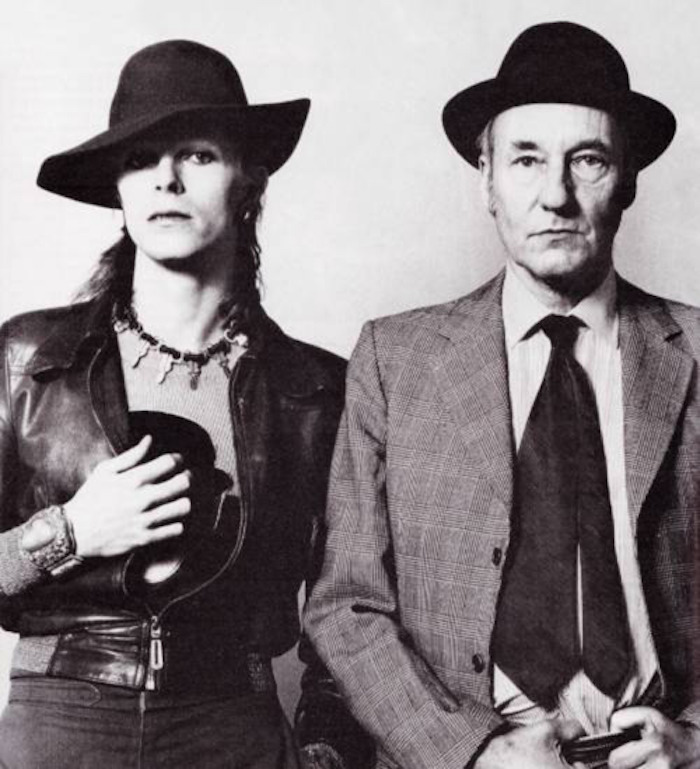

David Bowie and William Burroughs in 1974, photographed by Terry O'Neill. © V&A Images
It was November 19, 1973, and Bowie and Burroughs had been brought together for what was, in effect, a two-way interview by a journalist from Rolling Stone magazine. In preparation for the meeting, Burroughs had read all of Bowie’s lyrics while Bowie had immersed himself in Burroughs’ cult novel from 1964, Nova Express, a book that had used the cut-up technique with pioneering effect.

Burroughs demonstrating his cut-up method in the 1983 documentary Burroughs
It was November 19, 1973, and Bowie and Burroughs had been brought together for what was, in effect, a two-way interview by a journalist from Rolling Stone magazine. In preparation for the meeting, Burroughs had read all of Bowie’s lyrics while Bowie had immersed himself in Burroughs’ cult novel from 1964, Nova Express, a book that had used the cut-up technique with pioneering effect.

Burroughs demonstrating his cut-up method in the 1983 documentary Burroughs
Bowie was at a crossroads in his career. He had killed off his alter ego Ziggy Stardust that previous June when he had sensed that the originality of his vision was being assimilated into the cultural mainstream through glam rock. He was too artistically astute, too culturally savvy, and too mercurial to allow himself to become locked into the standard rock star formulae, endlessly repeating himself in a diminishing cycle of self-imitation. The cut-up was a technique that offered him a way out. It was a way to transform his method of writing lyrics, as well as a new method to understand himself. It was a means of “igniting anything that might be in my imagination.”
Burroughs was the perfect conduit to allow Bowie to break out of his creative dead end and into his artistic future via a wormhole into the past. Burroughs connected Bowie back to the avant-garde Dadaists of the 1920s and their radical new use of language. Tristan Tzara’s Dada manifesto, On Feeble and Bitter Love, first introduced this idea of the cut-up:
Take a newspaper.
Take some scissors.
Choose from this paper an article of the length you want to make your poem.
Cut out the article.
Next carefully cut out each of the words that makes up this article and put them all in a bag.
Shake gently.
Next take out each cutting one after the other.
Copy conscientiously in the order in which they left the bag.
The poem will resemble you.
And there you are—an infinitely original author of charming sensibility, even though unappreciated by the vulgar herd.
The cut-up wasn’t an intellectual exercise for Bowie, it was a pragmatic technique, a “very Western tarot,” that injected chance and accident into his song writing process. It freed him from the bind of self-expression.
Burroughs had learned the technique from his collaborator and friend, the British artist Brion Gysin. They had met Paris at a flophouse that would later be called the Beat Hotel (Allan Ginsburg wrote part of his poem Howl there). Gysin worked in a range of media, including calligraphic painting, writing, filmmaking, and audio experimentation, all influenced by drugs and infused with mysticism. In 1959 he introduced the cut-up technique to Burroughs who immediately recognized its importance. (A recording of The Cold Spring Tape, in which Burroughs, Gysin, and Genesis P. Orridge discuss their cut-up method can be listened to here.) “The cut-up method brings to writers the collage, which has been used by painters for fifty years.” Together they collaborated on an experimental book The Third Mind.
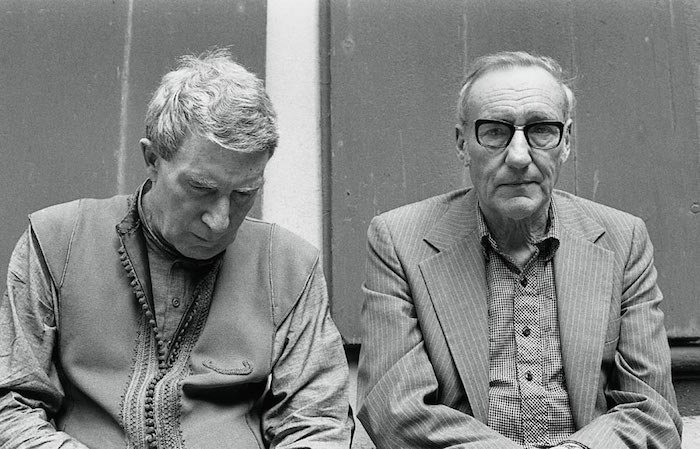
Gysin and Burroughs in Basel, 1979; photo © Ulrich Hillebrand
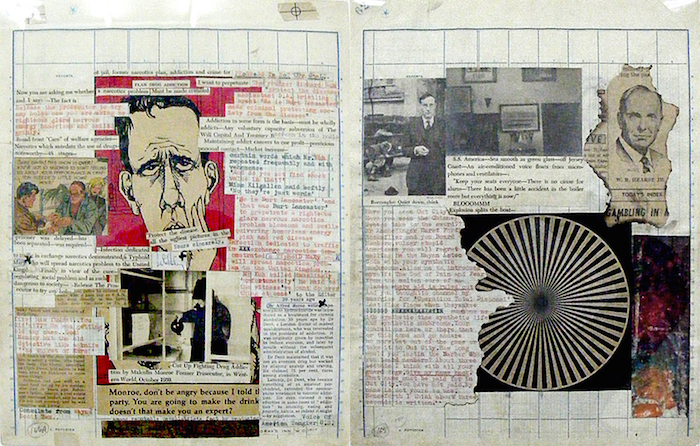
A cut-up by Brion Gysin and William Burroughs from the book The Third Mind
After meeting Burroughs in November 1973, Bowie began to use the cut-up technique in his own work. “My thought forms are already fragmented, to say the least,” he would later say. “I’ve had to do cut-ups on my own writing for some time so that I might be able to put it back into some coherent form again.” It was a period in his life when he was personally in danger of fragmenting, and the cut-up suited his state of mind as well as his need for artistic growth.
In February 1974 he recorded his next album, Diamond Dogs, and he used the cut-up for the medley "Sweet Thing/Candidate/Sweet Thing" as well as for the title track. The method perfectly suited the dystopian temper of the album: distanced, less pop-personal, but jarring, disconnected, and compelling.
In the 1974 BBC documentary Cracked Actor, Bowie demonstrates his cut-up method on camera. Snipping out pages from a journal, looking emaciated (are those lines of cocaine on the table?), but precisely articulate, he mentions both Gysin and Burroughs. He used their method mostly in his own writings, he says (they worked from already printed sources), and as a result the cut-up “seems to predict things about the future and tell me a lot about the past.”
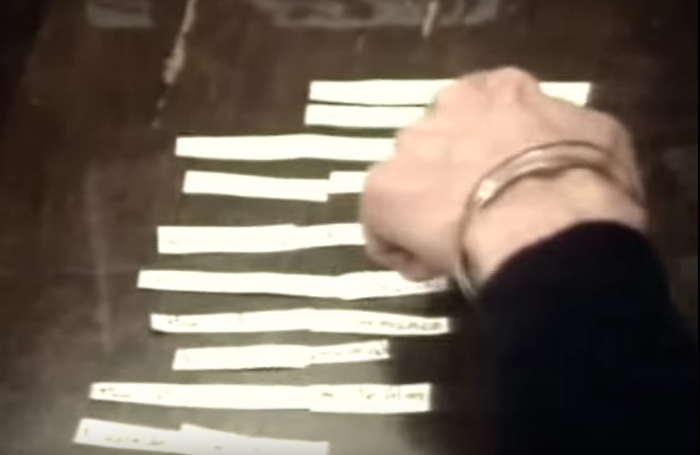
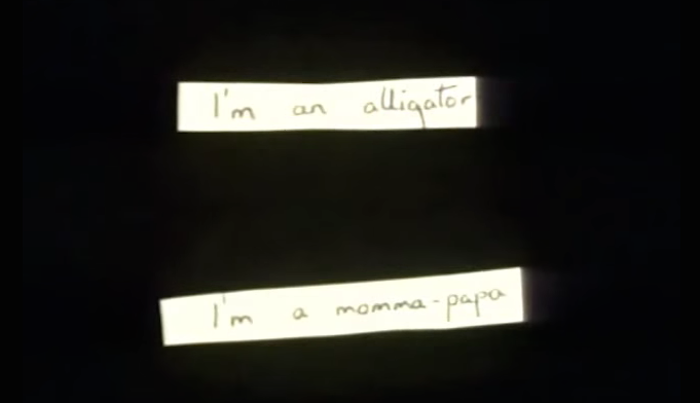
Bowie displays his cut up technique in stills from Cracked Actor
Bowie’s genius was to forge avant-garde art traditions with his astonishingly inventive musical sensibility. Over lunch he had admitted to Burroughs that he changed his mind often, that he was hardly ever consistent, and that he never wanted to stand still “on one point” for his entire life. The cut-up would give his work “some new energy.”
Did Bowie then apply the cut-up technique to his own cultural personae, igniting his rapid-fire montage of transformations that would propel him through the 1970s and beyond? Was he the embodiment of Tzara’s infinitely original author? “Cut up everything in sight,” wrote Gysin, “make your whole life a poem.”
Homepage image: David Bowie and William Burroughs in 1974, photographed by Terry O'Neill and hand-colored by Bowie. © V&A Images
